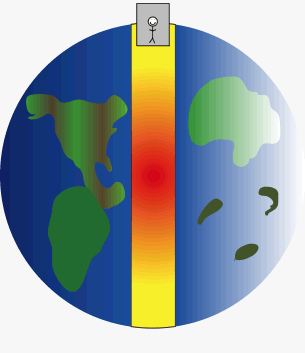Gravity train
From Wikipedia, the free encyclopedia

A gravity train is a theoretical means of transportation intended to go between two points on the surface of a sphere, following a straight tunnel that goes directly from one point to the other through the interior of the sphere.
In a large body such as a planet, this train could be left to accelerate using just the force of gravity, since, during the first half of the trip (from the point of departure until the middle), the downwards pull towards the center of gravity would pull it towards the destination. During the second half of the trip, the acceleration would be in the opposite direction relative to the trajectory, but (ignoring the effects of friction) the speed acquired before would be enough to cancel this deceleration exactly (so that the train would reach its destination with speed equal to zero).
Contents |
[edit] Objections
In reality, there are two reasons gravity trains do not exist. The transit shown in the illustration would pierce the earth's mantle and traverse a region where rock is more fluid than solid. No materials are known that would withstand the tremendous heat and pressure. Secondly, friction losses would be significant. Rolling friction losses could be reduced by using a magnetically levitated train. However, unless all air is evacuated from the tunnel, friction losses due to air resistance would rise with the square of the velocity. Evacuating the atmosphere to make it a vactrain and eliminate drag would require additional power. The concept could work on bodies of mass such as the Moon, as it is solid and without an atmosphere.
A gravity train can be seen as an extreme version of a roller coaster, with only a downward slope followed by an upward slope. In more technical terms, it is a linear oscillator.
[edit] Origin of the concept
In the 17th century, British scientist Robert Hooke presented the idea of an object accelerating inside a planet in a letter to Isaac Newton. A gravity train project was seriously presented to the Paris Academy of Sciences in the 19th century. The idea was rediscovered in the 1960s when physicist Paul Cooper published a paper in the American Journal of Physics suggesting that gravity trains be considered for a future transportation project.[1]
[edit] Mathematical considerations
The gravity train has several curious properties.
- All straight-line gravity trains on a given planet take exactly the same amount of time to complete a journey (that is, no matter where on the surface the two endpoints of its trajectory are located). For Earth, this time would equal 42 minutes and 12 seconds if it were a perfect sphere.[citation needed]
- The time of a trip depends only on the density of the planet and the gravitational constant.
- The maximum speed is reached at the middle point of the trajectory. For a train that goes directly through the center of the Earth, this maximum speed is about 7,900 metres per second.
- The derivation assumes that the mass is distributed homogeneously throughout the earth.
- The shortest time tunnel through a homogeneous earth is a Hypocycloid.
[edit] References
- ^ "To Everywhere in 42 Minutes". http://jcgi.pathfinder.com/time/magazine/article/0,9171,842469,00.html.
- Description of the concept Gravity train and mathematical solution (at Purdue University).
- The Amazing 42-Minute Gravity Sled, at the Hitch-Hiker's Guide to the Galaxy website.

